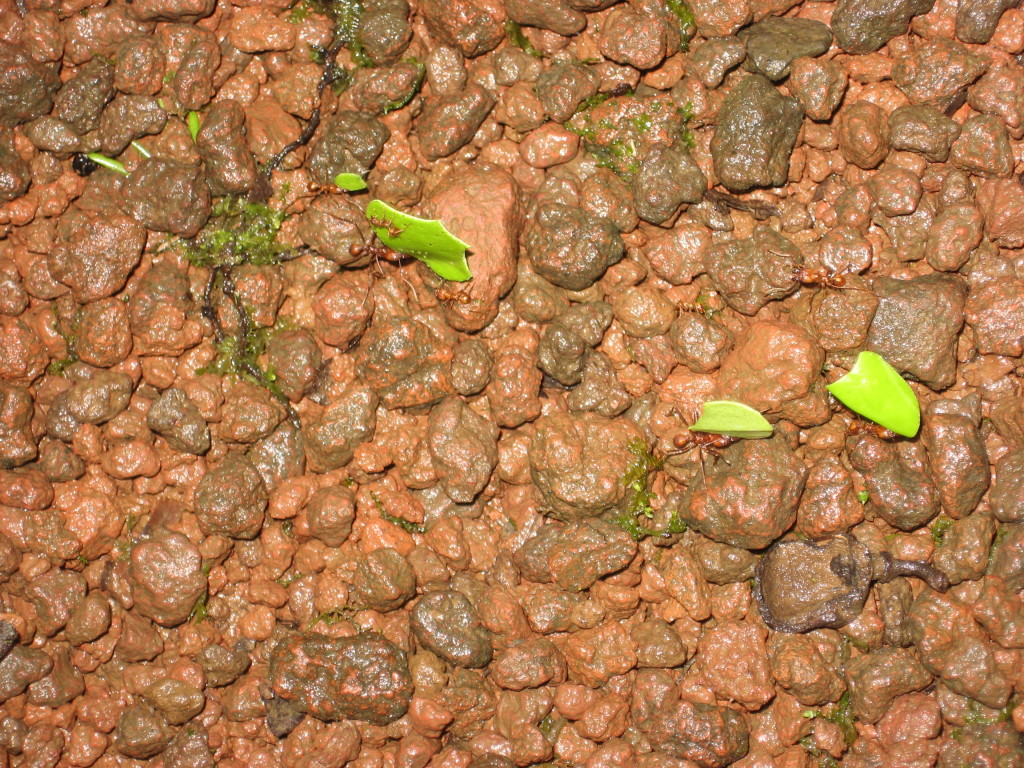In the Sarapiqui rainforest in northeastern Costa Rica, we watched a long line of cutterants hard at work carrying green bits of leaves down a tree trunk and along the ground enroute to their nest. Hoisting the fragments above their heads, these little stevedores are herculean since the leaves can be three times their body weight.
Surprisingly, the ants don’t eat the leaves but instead bring them to an underground chamber and feed them to a soft, spongy fungus that they cultivate for food. Cutterants are farmers par excellence! They work in a multifaceted partnership that makes their fungus farming successful.
An average nest has 5 million ants living in a complex system of tunnels and chambers that can be the size of a small car. The queen is the heart of the colony and can lay 30,000 eggs a day.
The ant workforce is quite diversified. Each ant type has specific work assignments. Media ants do the leaf cutting and the heavy lifting and portage. Large-jawed soldiers patrol and protect the ants as they journey back to the nest with their green cargo. Another ant group distributes leaf bits to the fungus. The smallest ants, the minimae, tend the fungus. They often hitch a ride on transported leaves to clean off competing fungal spores. (A minima is riding the leaf towards the top of my photograph.) Minimas chew leaves into smaller pieces, adding feces and saliva and attaché this sticky material to the fungus.
They fertilize their fungus garden using nitrogen-fixing bacteria. They kill unwanted garden parasites with a type of Streptomyces bacteria that resides on the ants’ exoskeleton. The ants don’t fall prey to insecticides produced by plants because the friendly fungus zaps them.
Leafcutter ants and the antimycin compounds linked with the Streptomyces they carry have inspired research on anti-cancer drugs to use against chemotherapy-resistant cancer cells.
Ants secrete a chemical trail that leds them back to their nest. They communicate rapidly and don’t need Facebook to form a “flash mob”. Remember their lightening-speed communication skills next time you have a parade of ants invade your picnic or kitchen.
Ants never captured my imagination as a child but here I am awestruck by their ingenuity, synergy and work ethic. Maybe — just maybe — an Uncle Milton’s ant farm is in order for all of us to learn big lessons from the tiny ant.


Love this.
Isn’t nature incredible… at all levels.. micro and macro. Thanks for this interesting and edifying piece. Best Marc
I just read an essay on Ant colonies and how we are very like them. Thank you Susan
Wow, Susan! I saw those cutter ants with you in Costa Rica, but never realized what industrious and amazing creatures they are. Your writing is fun to follow and “herculean” is a good description of these ants efforts. Thank you for such an informative and fun article.
Thanks for your great research! I like the details of who does what. A fascinating creature and a fascinating post.
This is just amazing, Susan. I had no idea that an any colony could be so complex and productive. Very, very interesting.
We saw them when we were in Costa Rica but didn’t have anyone as knowledgeable as you explaining how industrious they are. Vey impressive report. Thanks, Peggy
This was fun, Susan… to look at a micro world that is so vast and below our awareness level, usually. What’s interesting to me is that by looking at this “underground” world, I found a kind of relief from some of the problems of this everyday world heard from the TV news in my living room. At least for a while. Thank you, Susan!
We also saw ants while in Costa Rica and they were carrying objects much heavier than they were. Thanks Susan for bring back a happy memory and educating me at the same time. Bridget
We saw them in Costa Rica, too. The guide told us they’re blind. Amazing little creatures.
Love your informative articles. Love to read and educate myself. Thank you.
To everything there is a purpose under heaven : ) Thanks for reminding us. Loved this post.
Great! I loved this article! These ants are so amazing. I always had an ant farm in my classroom and I enjoyed watching them as much as my class. You really do your research and it’s wonderful to read. Keep them coming.
Fantastic post! You reminded me of the ant farm I made in 1961 for a science fair in high school. Ants are one of nature’s super amazing critters…talk about team work! Thanks!!!